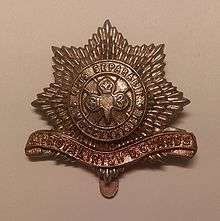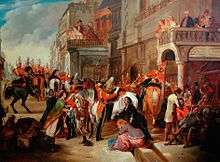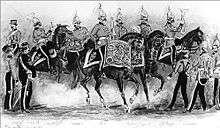4th Royal Irish Dragoon Guards
| 4th Royal Irish Dragoon Guards | |
|---|---|
 Badge of the 4th Royal Irish Dragoon Guards | |
| Active | 1685–1922 |
| Country |
|
| Branch |
|
| Type | Cavalry |
| Role | Line Cavalry |
| Size | 1 Regiment |
| Nickname(s) | The Blue Horse, The Mounted Micks, The Buttermilks |
| Motto(s) | Quis separabit (Who shall separate us?) |
| March |
Quick: St. Patrick's Day Slow: 4th Dragoon Guards |
| Commanders | |
| Notable commanders |
Lieutenant-General James Hamilton, 4th Duke of Hamilton |
The 4th Royal Irish Dragoon Guards was a cavalry regiment in the British Army, first raised in 1685 as the Earl of Arran's Regiment of Cuirassiers. It was renamed as the 4th (Royal Irish) Dragoon Guards in 1788 and service for two centuries, including the First World War, before being amalgamated with 7th Dragoon Guards (Princess Royal's), to form the 4th/7th Dragoon Guards in 1922.
History


The regiment was first raised by James, Earl of Arran as the Earl of Arran's Regiment of Cuirassiers in 1685 as part of the response to the Monmouth Rebellion, by the regimenting of various independent troops, and was ranked as the 6th Regiment of Horse.[1] It fought at the Battle of the Boyne in July 1690[2] and the Battle of Steenkerque in August 1692 during the Williamite War in Ireland.[3] In 1691 it was re-ranked as the 5th Horse, and in 1746 transferred to the Irish regiment establishment where it was the ranked 1st Horse. It returned to the British establishment in 1788, as the 4th (Royal Irish) Dragoon Guards.[1]
The regiment was then involved in activities in support of the Invasion of France by émigrés in June 1795 before taking part in fighting at the Battle of Naas on 24 May 1798, the Battle of Prosperous also on 24 May 1798 and the Battle of Tuberneering on 4 June 1798 during the Irish Rebellion. At Tuberneering a troop from the regiment were ambushed and the troop commander, Lieutenant-Colonel Walpole and 100 of his men died.[3] The regiment went on to fight at the Battle of Arklow on 9 June 1798 and the Battle of Vinegar Hill on 21 June 1798.[2]


The regiment was deployed to the Peninsula in 1811 and fought under General Sir John Slade at the Siege of Ciudad Rodrigo in January 1812 during the Peninsular War.[3] It also took part in the charge of the Heavy Brigade at the Battle of Balaclava in October 1854 during the Crimean War and in the Battle of Tel el-Kebir in September 1882 during the Anglo-Egyptian War.[2]

The regiment landed in France at the outbreak of the First World War as part of the 2nd Cavalry Brigade in the 1st Cavalry Division on 16 August 1914 for service on the Western Front.[4] Perhaps the most notable engagement of the regiment was on 22 August 1914, when a squadron of the regiment became the first members of the British Expeditionary Force to engage the German army outside Mons; four patrolling German cavalrymen of the 2nd Kuirassiers were surprised by two full troops of British cavalry, and after a brief pursuit several were killed. Captain Charles Hornby was reputed to have become the first British soldier to kill a German soldier, using his sword, and Drummer Edward Thomas is reputed to have fired the first British shots of the war.[5]
In 1921, it was retitled the 4th Royal Irish Dragoon Guards and in 1922 was amalgamated with 7th Dragoon Guards (Princess Royal's), to form the 4th/7th Dragoon Guards.[1]
Battle honours
The regiment's battle honours were as follows:[1]
- Early Wars: Peninsular, Balaklava, Sevastopol, Tel-el-Kebir, Egypt 1882
- The Great War: Mons, Le Cateau, Retreat from Mons, Marne 1914, Aisne 1914, La Bassée 1914, Messines 1914, Armentières 1914, Ypres 1914 '15, St. Julien, Frezenberg, Bellewaarde, Somme 1916 '18, Flers-Courcelette, Arras 1917, Scarpe 1917, Cambrai 1917 '18, St. Quentin, Rosières, Amiens, Albert 1918, Hindenburg Line, Pursuit to Mons, France and Flanders 1914-18
Colonels
The colonels of the regiment were as follows:[1]
- Earl of Arran's Cuirassiers and 6th Regiment of Horse
- 1685-1688 James, Earl of Arran later Duke of Hamilton. app. 28 July 1685 —The Earl of Arran’s Horse
- 1688-1688 Charles, Earl of Selkirk. app. 20 November 1688 —The Earl of Selkirk’s Horse
- 1688-1693 Charles Godfrey. app. 31 December 1688
- from 1691 5th Regiment of Horse
- 1693-1713 Francis Langstone. app. 7 March 1693 —Langton’s Horse
- 1713-1715 George Joceline. app. 29 October 1713 —Jocelyn’s Horse
- 1715-1729 Sherrington Davenport. app. 9 February 1715 —Davenport’s Horse (also The Prince of Wales’s Own Regiment of Horse)
- 1729-1732 Owen Wynne. app. 6 July 1729 —Wynne’s Horse
- 1732-1739 Thomas Pearce. app. 29 September 1732 —Pearce’s Horse
- 1739-1743 James, Lord Tyrawley. app. 26 August 1739 —Trawley’s Horse
- 1743-1762 John Brown. app. 1 April 1743 —John Brown’s Horse
- from 1746 1st (Irish) Regiment of Horse and 4th Dragoon Guards or 1st Horse (Irish Establishment) or Blue Horse
- in the Irish establishment (from the British establishment)
- from 1746 1st (Irish) Regiment of Horse and 4th Dragoon Guards or 1st Horse (Irish Establishment) or Blue Horse
On 1 July 1751 a royal warrant provided that in future regiments would not be known by their colonels' names, but by their "number or rank".
- 1762-1775 James Johnston (Johnston of the Blues). app. 3 August 1762
- 1775-1778 James Johnston (Irish Johnston). app. 27 April 1775
- 1778-1803 George Warde. app. 1 April 1778
- from 1788 4th (Royal Irish) Dragoon Guards
- in the British establishment (from the Irish establishment)
- from 1788 4th (Royal Irish) Dragoon Guards
- 1803–1814 Lt-Gen. Miles Staveley
- 1814–1827 Gen. Sir Henry Fane, GCB
- 1827–1849 Gen. Sir George Anson, GCB
- 1849–1868 Gen. Richard Pigot
- 1868–1874 Gen. Sir James Charles Chatterton, 3rd Baronet, GCB, KH
- 1874–1894 Gen. Sir Edward Cooper Hodge, GCB
- 1894–1896 Lt-Gen. William Godfrey Dunham Massy, CB
- 1896–1908 Lt-Gen. Sir Henry Clement Wilkinson, KCB
- 1908–1922 Lt-Gen. Sir Edward Cecil Bethune, KCB, CVO
- from 1921 4th Royal Irish Dragoon Guards
In 1922 the regiment was amalgamated with the 7th Dragoon Guards (Princess Royal's) to form the 4th/7th Royal Dragoon Guards.
See also
References
- 1 2 3 4 5 "4th Royal Irish Dragoon Guards". Regiments.org. Archived from the original on 16 April 2007. Retrieved 5 August 2016.
- 1 2 3 "4th Royal Irish Dragoon Guards". National Army Museum. Retrieved 5 August 2016.
- 1 2 3 "4th Dragoon Guards". British Empire. Retrieved 5 August 2016.
- ↑ "The Dragoon Guards". The Long, Long Trail. Retrieved 5 August 2016.
- ↑ "The British soldier who fired the first shot of World War I". The Mirror. 9 August 2014. Retrieved 5 August 2016.
External links
| Wikimedia Commons has media related to 4th Royal Irish Dragoon Guards. |
- "History of the Royal Dragoon Guards". Archived from the original on 28 July 2008. Retrieved 26 August 2010.